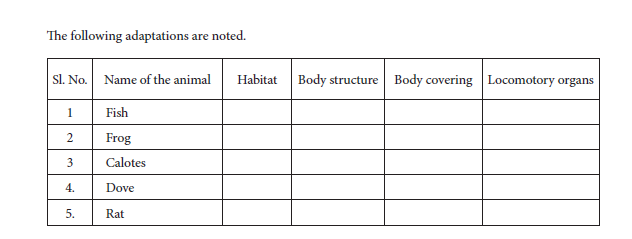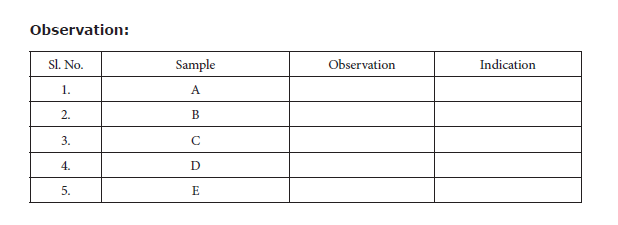Many students of class 9 Science may disregard practical as unimportant. However, for the board exams a section of the question paper is designed to include practical questions. Tamil Nadu Board Class 9 Science Practicals are equally important for the students to get hands on experiment. Hence, we have tried to give an overview of the Tamil Nadu Board Class 9 Science Practical here. The article will provide information like the name of the experiment, important questions and so on.
Doing practicals helps students to not just understand the concept and subject, but it will also interest them to learn more. We have compiled here the list of experiments and table of contents for the Tamil Nadu board class 9 students.
Tamil Nadu Board Class 9 Science Practical – Table of Contents
| SI. No. | Name of the Experiment | Time |
| To find the diameter of a spherical body | 40 minutes | |
| 2. | To find the thickness of given iron nail | 40 minutes |
| 3 | Melting point of wax | 40 minutes |
| 4. | Measurement of volume of liquids | 40 minutes |
| 5. | Identification of adaptations in animals | 40 minutes |
| 6. | Identification of plant and animal tissues | 40 minutes |
| 7. | To detect the adulterants in food samples | 40 minutes |
| 8. | Identification of microbes | 40 minutes |
| 9. | Economic biology | 40 minutes |
| 10. | Identification of adaptations in plants | 40 minutes |
TN Board Class 9 Practicals Science-List of Experiments
The laboratory manual or the list of experiments given here is so that students who are doing the practicals for the first time will be able to know how to go about it. This description given below will inform students about the various lab facilities, measuring instruments, chemicals, glasswares, other equipment and such that are made available in the school laboratory.
Description of the experiment in the TN Class 9 Science Practical book follows the given format:
- Aim of the experiments
- Apparatus or materials required
- Formula or principle behind the experiment
- Procedure
- Observations
- Result
Download the TN Board Class 9 List of Practical-Science Free PDF
Check the List of Class 9 Science Experiment from below:
I. TO FIND THE DIAMETER OF A SPHERICAL BODY
Aim: To determine the diameter of a spherical body using Vernier Caliper.
Apparatus required: Vernier Caliper, given spherical body ( cricket ball).
Formula:
(i) Least count (LC) =1 Main scale division -1 Vernier scale division
LC = 1mm – 0.9 mm
LC = 0.1 mm (or) 0.01 cm
(ii) Diameter of the spherical object (d) = M.S.R. + (VC × LC) ± ZC cm
where,
MSR – Main Scale Reading
VC – Vernier Coincide
LC – Least Count. (0.01 cm)
ZC – Zero Correction.
Procedure:
• Find the least count of the Vernier caliper.
• Find the zero correction of the Vernier caliper.
• Fix the object firmly in between the two lower jaws of the Vernier.
• Measure the main scale reading and the Vernier scale coincidence.
• Repeat the experiment by placing the jaws of the Vernier at different position of the object.
• Use the formula to find the diameter of the object.
Outcome:
Least Count (LC): 0.01cm Zero Correction (ZC): _______________

Result: The diameter of the given spherical object (Cricket ball) is _______ cm
II. TO FIND THE THICKNESS OF GIVEN IRON NAIL
Aim: To find the thickness of the given iron nail.
Apparatus required: Screw gauge and iron nails.

Error:
(i) If positive error is 5 points, for zero correction, subtract 5 points.
t= PSR + (HSC × LC) – ZC
t= PSR + (HSC × LC) – 5
(ii) If negative error is 95 points, for zero correction add 5 points (100 -95 =5).
t= PSR + (HSC × LC) + ZC
t= PSR + (HSC × LC) + 5
(iii) If no correction is needed, t = PSR + (HSC × 0.01) ± 0
Procedure:
• The least count of screw gauge is 0.01 mm.
• The zero error is to be found when the two faces of the screw gauge touch each other.
• Then place the iron nail between the two faces of the screw gauge. The pitch scale reading.
(PSR) and head scale coincidence (HSC) are to be noted.
• Repeat the process by placing other parts of the iron nail in the screw gauge.
• Tabulate the readings.
Outcome:

Result: The diameter (Thickness) of the iron nail is _______ mm.
III. MELTING POINT OF WAX
Aim: To determine the melting point of wax using cooling curve.
Principle:
The determination of melting point is based on latent heat which is the amount of heat required to change a unit mass (1gm) of a substance from one state to another state without changing its temperature.
Materials Required: Beaker, burner, thermometer, boiling tube, retort stand and clamp,wire gauze, tripod stand, candle wax, stop watch, bowl of sand.
Procedure:
• Melt the wax in a warm water bath.
• When the wax is melted entirely, remove it from the bath, dry it and then bury it in sand.
• Record the temperature every 30 seconds while the liquid is being converted to solid.
• At the same time watch for constant temperature at which liquid and solid are present.
Melting point of wax= Constant Temperature over a period of time


Suggestion: With the help of ICT corner, the teacher can show the live video of the experiment of melting point of wax using the link www.kau.edu.sa
IV. MEASUREMENT OF VOLUME OF LIQUIDS
Aim: To measure the volume of given colourless and coloured liquids.
Materials required: Pipette (20ml), sample liquids and beakers
Procedure:
Take a 20 ml pipette. Wash it thoroughly with water and then rinse it with the given liquid. Insert the lower end of the pipette into the given liquid and suck the solution slowly till the solution rises well above the circular mark on the stem. Take the pipette out of the mouth and quickly close it with the fore finger. Take the pipette out the liquid and keep it in such a way that the circular mark on the stem is at the level of the eyes. Now slowly release the fore finger to let the liquid drop out until the lower meniscus touches the circular mark on the stem. If the liquid in the pipette is exactly 20 ml, this can be transferred to an empty beaker by removing the fore finger.

Report: Exactly 20 ml of various liquids are measured using a standard 20 ml pipette.
Note:
1. Keeping the circular mark on the stem of the pipette above or below the level of the eyes will lead to error.
2.When colored liquids are measured, the upper meniscus should be taken into account.
3. Never suck strong acids or strong alkalis using a pipette.
V. IDENTIFICATION OF ADAPTATIONS IN ANIMALS
Aim: To identify the given vertebrate animals and list out the adaptations seen in them.
Required specimens:
1. Pisces (Fish), 2. Amphibian (Frog), 3. Reptile (Calotes), 4. Aves (Dove), 5. Mammal (Rat)

VI. IDENTIFICATION OF PLANT AND ANIMAL TISSUES
Aim: To identify the structural features of plant and animal tissues from permanent prepared slides.
Observation: Identify the given plant and animal tissues.
a) Simple tissues – parenchyma, collenchyma, sclerenchyma
b) Complex tissues -xylem and phloem
c) Epithelial tissue – columnar epithelium, ciliated epithelium
d) Connective tissue – section of bone
e) Muscle tissue – skeletal muscle, smooth and cardiac muscle
f) Nerve tissue
Draw a labelled sketch and write the location and function of the tissues observed.
VII. TO DETECT THE ADULTERANTS IN FOOD SAMPLES
Aim: To detect the adulterants in the given samples.
Requirements: Beakers, glass bowl, spoon and match box.
Materials required:
Given samples: pepper (A), honey (B), sugar (C), chilli powder (D), green peas (E) and water.
Procedure:
• Take 5 beakers with water and label it as A, B, C, D, E.
• Take samples A, B, C, D, E and add to the respective beaker.
• Observe the changes in each beaker.
• Record your observations.

VIII. IDENTIFICATION OF MICROBES
Aim: To identify the different types of microbes (Bacteria and Virus).
Observation: To observe the following with the help of photograph/picture/permanent slide using a compound microscope/model/bio visual chart.
a. Escherichia coli
b. Vibrio cholerae
c. Lactobacillus
d. Retrovirus (HIV)
Answer the following:
a. Draw a neat labelled diagram.
b. Write the shape of the bacteria and virus observed.
c. Mention the structural details of the bacteria and virus.
d. Indicate its microbial importance/disease caused.
IX. ECONOMIC BIOLOGY
Aim: To identify the plants and animals of economic importance.
Observation: To observe the following using specimen/photograph/picture/model.
a. Biofertilizer – Rhizobium
b. Medicinal plants – Nilavembu, Aloe vera
c. Mushroom – Agaricus bisporus
d. Indigenous cattle breed – Umblachery
e. Indian major carp – Catla catla
f. Type of honey bees – Queen bee, Worker bee
Answer the following:
a. Draw a neat labelled sketch
b. Write its economic importance
X. IDENTIFICATION OF ADAPTATIONS IN PLANTS
Aim: To identify the given plant specimen and list out its adaptations
1. Mesophytic plant – Tomato or Brinjal plant
2. Xerophytic plant – Opuntia
3. Aquatic plant – Eichhornia sp
4. Insectivorous plant – Nepenthes
Observation: The given plants are identified and the following adaptations are noted.
1.
2.
3.
4.
5.
Keep learning and stay tuned to BYJU’S to get updates about TN board and its resources including the TNBSE Practicals!

Comments